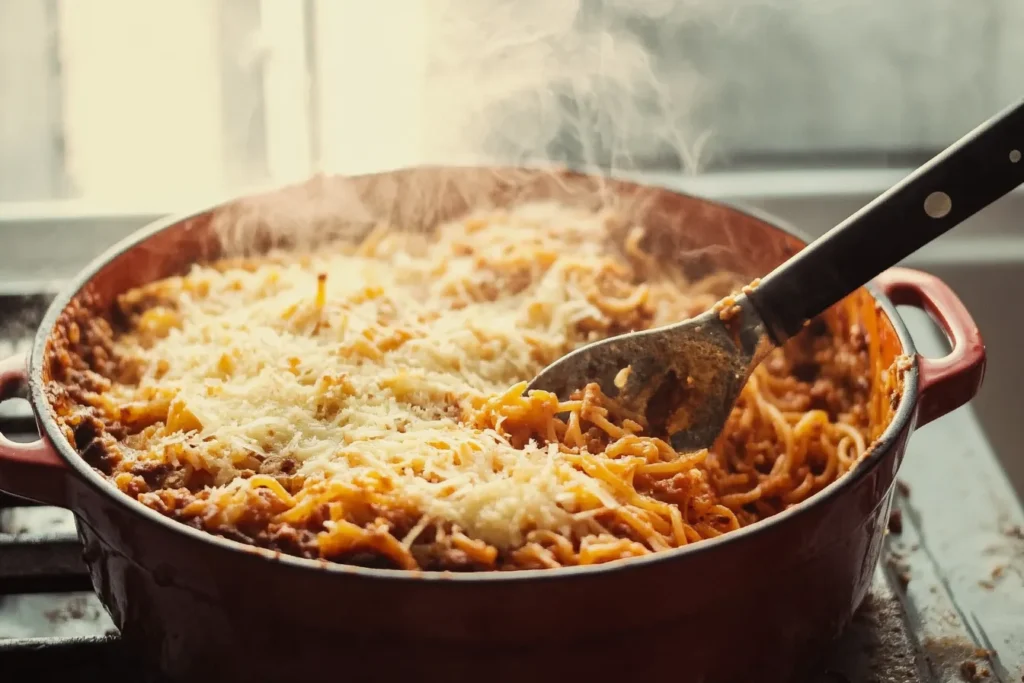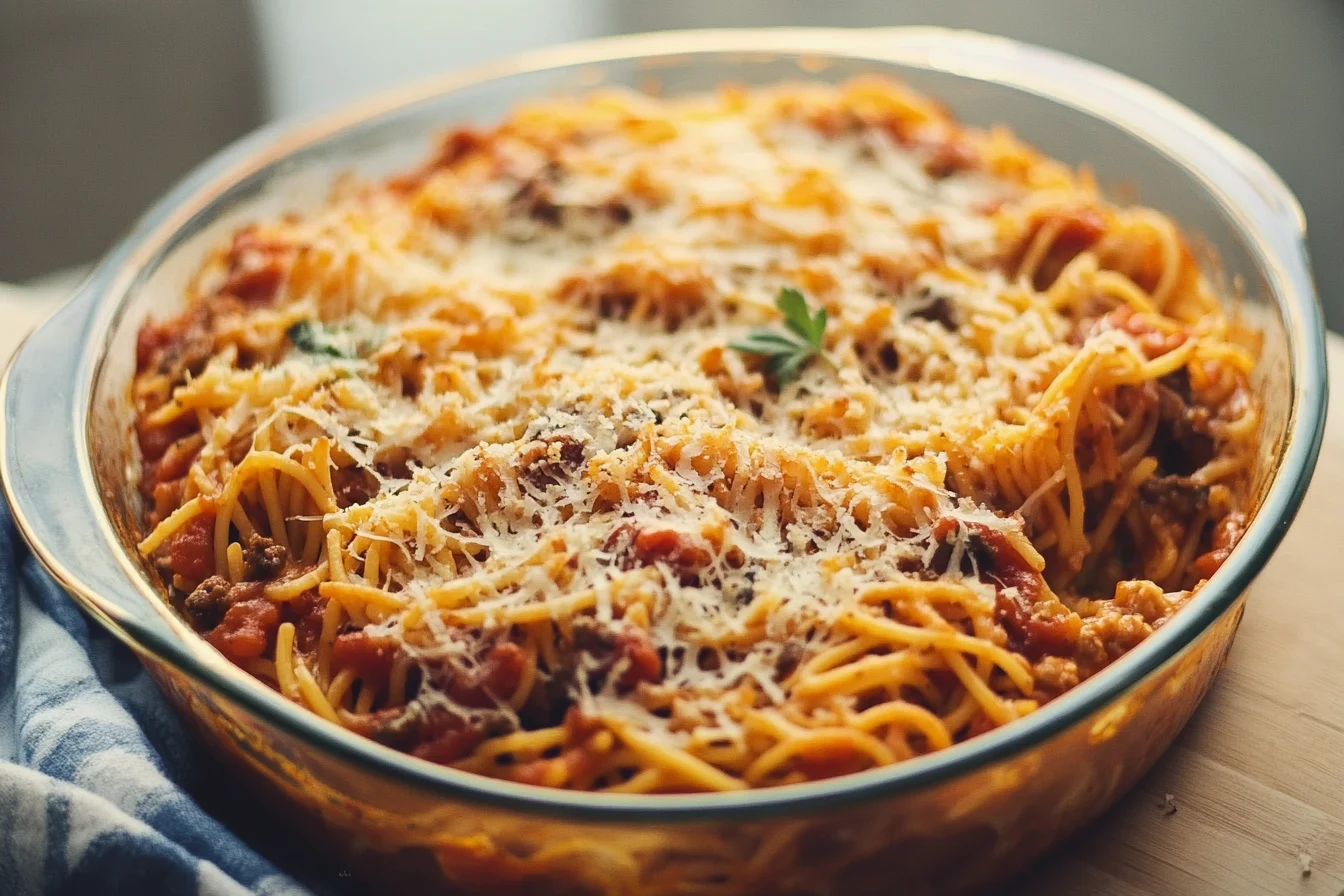Spaghetti casserole recipe is a baked dish that combines cooked spaghetti pasta with a savory sauce, layers of cheese, and optional proteins or vegetables. This hearty meal is baked until golden and bubbly, making it a comfort food classic for family dinners and gatherings. Easy to customize, spaghetti casserole can range from simple recipes with pantry staples to elaborate creations with gourmet ingredients.

The History and Origin of Spaghetti Casserole
Spaghetti casserole has its roots in Americanized Italian cuisine, where traditional pasta dishes were adapted to suit the convenience of baking. Casseroles gained popularity in the mid-20th century as an efficient way to create one-dish meals. The use of ingredients like tomato sauce, pasta, and cheese reflects the influence of Italian immigrants on American cooking.
How Casseroles Became a Household Favorite
Casseroles became a staple in American households because they are:
- Easy to Prepare: Simple assembly and baking.
- Time-Saving: Ideal for busy families.
- Economical: Uses affordable ingredients and stretches them to feed a crowd.
Why Spaghetti Casserole Is a Comfort Food Classic
Spaghetti casserole’s appeal lies in its:
- Rich Flavors: The combination of savory sauce, melted cheese, and tender pasta.
- Versatility: Can be customized with a variety of ingredients.
- Nostalgia: Often associated with family dinners and potlucks.
Ingredients Needed for Spaghetti Casserole
Choosing the Right Type of Spaghetti
- Classic Spaghetti: Works well for most recipes.
- Thin Spaghetti: Cooks quickly but may become too soft if overbaked.
- Whole Wheat or Gluten-Free Options: Great for healthier or dietary-specific versions.
Sauce Options: Tomato-Based, Alfredo, or Mixed
The sauce is the foundation of the dish. Choose from:
- Tomato-Based Sauce: Marinara or meat sauce for a traditional flavor.
- Alfredo Sauce: For a creamy, indulgent twist.
- Mixed Sauce: Combine tomato and cream sauces for a rich, tangy balance.
Proteins and Add-Ins: Ground Beef, Sausage, or Vegetarian Choices
Customize the casserole with these options:
- Meat: Ground beef, Italian sausage, shredded chicken, or bacon.
- Vegetarian: Mushrooms, spinach, zucchini, or bell peppers for a plant-based option.
- Cheese: Mozzarella, cheddar, ricotta, or parmesan for added creaminess.
Nutritional Benefits of Spaghetti Casserole
Calorie Breakdown and Key Nutrients
A serving of spaghetti casserole provides:
- Calories: Around 300–500 per serving (varies with ingredients).
- Nutrients:
- Carbohydrates from pasta for energy.
- Protein from meat or plant-based alternatives.
- Calcium from cheese.
Healthy Ingredient Alternatives for a Lighter Dish
Make your casserole healthier with these swaps:
- Use whole wheat spaghetti or zucchini noodles for added fiber.
- Replace cream-based sauces with low-fat marinara.
- Opt for low-fat cheese or reduce the overall amount used.
Tools and Equipment Needed
Baking Dish Types: Glass, Ceramic, or Metal
The type of baking dish can affect the outcome:
- Glass or Ceramic: Retains heat well and offers even cooking.
- Metal: Heats quickly but may overcook edges if not monitored.
Mixing Bowls, Spatulas, and Graters
Essential tools include:
- Mixing Bowls: For combining the pasta, sauce, and other ingredients.
- Spatulas: For spreading layers evenly.
- Graters: For freshly grated cheese, which melts better than pre-shredded varieties.
How to Make Perfect Spaghetti Casserole
Spaghetti casserole combines the ease of spaghetti with the heartiness of a baked dish. Follow these step-by-step instructions to create a delicious meal for any occasion
Boiling the Spaghetti to Al Dente
- Choose the Right Pot: Use a large pot with enough water to allow the spaghetti to cook evenly.
- Salt the Water: Add 1–2 tablespoons of salt to enhance the pasta’s flavor.
- Cook the Spaghetti: Boil until just al dente—firm to the bite. This prevents overcooking during baking.
- Drain and Rinse (Optional): Drain the pasta in a colander. If not assembling immediately, rinse with cold water to stop the cooking process.
Preparing the Sauce: Homemade vs. Store-Bought
- Homemade Sauce:
- Sauté onions and garlic in olive oil until fragrant.
- Add crushed tomatoes, tomato paste, and Italian seasonings like oregano and basil.
- Simmer for 20–30 minutes to develop flavors.
- Store-Bought Sauce:
- Use high-quality marinara or Alfredo sauce.
- Enhance with fresh herbs, minced garlic, or a splash of red wine.
Preheating the Oven and Greasing the Baking Dish
- Preheat the Oven: Set it to 375°F (190°C) to ensure even baking.
- Grease the Dish: Use butter, olive oil, or non-stick cooking spray to prevent sticking.
Assembling the Casserole
Layering the Ingredients: Pasta, Sauce, Cheese, and Protein
- Base Layer:
- Spread a thin layer of sauce on the bottom of the baking dish.
- Pasta Layer:
- Add a layer of cooked spaghetti, evenly distributing it.
- Cheese and Protein:
- Sprinkle with shredded mozzarella and add cooked ground beef, sausage, or vegetarian options.
- Repeat Layers:
- Alternate layers of sauce, pasta, and cheese until the dish is full, ending with a generous cheese layer.
Adding Vegetables or Extra Flavorings
Incorporate vegetables or flavor enhancers like:
- Vegetables: Sautéed spinach, diced bell peppers, mushrooms, or zucchini.
- Spices: Add a sprinkle of red pepper flakes for heat.
- Herbs: Fresh basil or parsley for garnish.
Topping with Cheese: Types and Quantities
- Use a mix of mozzarella, parmesan, and cheddar for a balanced flavor.
- Add breadcrumbs or a sprinkle of Italian seasoning for a golden, crispy topping.
Baking the Casserole
Baking Time and Temperature Tips
- Cover with Foil:
- To prevent the cheese from browning too quickly, cover the dish with foil for the first 20 minutes.
- Bake Uncovered:
- Remove the foil and bake for an additional 10–15 minutes to achieve a bubbly, golden top.
Checking for Doneness and Melting Cheese
- Visual Check:
- The cheese should be fully melted and slightly browned.
- Temperature Check:
- Insert a thermometer into the center of the casserole. It should read at least 165°F (74°C) for safety.
Common Mistakes to Avoid
Overcooking the Pasta
- Why It Matters: Overcooked pasta will become mushy during baking.
- Solution: Always cook the spaghetti to al dente and drain immediately.
Balancing the Sauce-to-Pasta Ratio
- Why It Matters: Too much pasta makes the dish dry; too much sauce makes it watery.
- Solution: Use about 2 cups of sauce for every 8 ounces of dry spaghetti.
Variations, Serving, and Storing Spaghetti Casserole
Variations of Spaghetti Casserole Recipe
Spaghetti casserole is endlessly versatile, allowing you to tailor it to your taste preferences and dietary needs. Here are some creative variations to try:
Meat-Lover’s Casserole: Ground Beef, Sausage, and Bacon
For a hearty, protein-packed version:
- Ingredients:
- Ground beef or turkey, Italian sausage, and crumbled bacon.
- Preparation:
- Brown the meats separately, drain any excess grease, and layer them between the pasta and sauce.
- Flavor Boost:
- Add a sprinkle of smoked paprika or chili flakes for extra depth.
This variation is perfect for carnivores craving a robust, satisfying meal.
Vegetarian Spaghetti Casserole with Seasonal Vegetables
A plant-based version can be just as flavorful:
- Ingredients:
- Sautéed zucchini, bell peppers, mushrooms, spinach, or eggplant.
- Preparation:
- Layer vegetables with marinara sauce and pasta.
- Cheese Option:
- Use ricotta or a dairy-free cheese alternative for added creaminess.
This casserole is a great way to incorporate more veggies into your diet.
Gluten-Free and Dairy-Free Spaghetti Casserole Options
For those with dietary restrictions:
- Gluten-Free:
- Use gluten-free spaghetti or alternative noodles like zucchini spirals.
- Dairy-Free:
- Replace cheese with vegan alternatives or nutritional yeast for a cheesy flavor.
- Sauce Adjustments:
- Check store-bought sauces for gluten or dairy content, or make your own.
This variation ensures everyone can enjoy the dish without compromising taste.
Italian-Inspired Casserole with Fresh Basil and Mozzarella
Elevate your casserole with authentic Italian flavors:
- Ingredients:
- Fresh basil, sliced mozzarella, and grated parmesan.
- Preparation:
- Layer fresh basil leaves between the pasta and sauce.
- Top with slices of mozzarella for a luxurious finish.
This version brings a touch of sophistication to your table.
Serving Spaghetti Casserole
Perfect Pairings: Garlic Bread and Side Salads
Complete your meal with these accompaniments:
- Garlic Bread:
- Toasted baguette slices brushed with garlic butter and herbs.
- Side Salads:
- A simple Caesar salad or mixed greens with a balsamic vinaigrette balances the richness of the casserole.
Turning Spaghetti Casserole Recipe into a Crowd-Pleasing Party Dish
For gatherings and potlucks:
- Double the Recipe: Prepare two casseroles in large baking dishes.
- Buffet-Style Serving: Offer toppings like extra cheese, herbs, or chili flakes so guests can customize their plates.
- Individual Portions: Bake in ramekins or small foil trays for a portable, single-serving option.
This approach makes it easier to serve large groups while maintaining the dish’s appeal.
Storing and Reheating Leftovers
Proper storage and reheating techniques ensure your casserole remains delicious even after the first serving.
Refrigeration Tips for Maximum Freshness
- Storage:
- Transfer the cooled casserole to an airtight container or cover the baking dish tightly with plastic wrap or foil.
- Refrigeration Duration:
- Store in the refrigerator for up to 3–4 days.
Freezing Spaghetti Casserole for Easy Future Meals
Spaghetti casserole freezes exceptionally well, making it a convenient meal prep option:
- Preparation for Freezing:
- Assemble the casserole without baking it.
- Cover tightly with plastic wrap and then aluminum foil to prevent freezer burn.
- Freezing Duration:
- Can be frozen for up to 3 months.
- Thawing and Baking:
- Thaw in the refrigerator overnight before baking.
- Bake as directed, adding an extra 10–15 minutes to account for the colder starting temperature.
Reheating Without Losing Texture or Flavor
To restore your casserole to its original deliciousness:
- Oven:
- Preheat to 350°F (175°C) and bake for 20–25 minutes, covered with foil.
- Microwave:
- Heat individual portions in a microwave-safe dish for 2–3 minutes, stirring halfway through.
- Prevent Drying Out:
- Add a splash of water or sauce before reheating to maintain moisture.
Fun Facts About Spaghetti Casserole Recipe
The Evolution of Spaghetti-Based Dishes
- Spaghetti has origins in ancient Roman cuisine, evolving into various pasta dishes we enjoy today.
- Baked pasta dishes, like spaghetti casserole, gained prominence in the mid-20th century as an economical way to feed families.
Spaghetti Casserole in Different Culinary Traditions
While spaghetti casserole is commonly associated with Americanized Italian cuisine, similar dishes exist worldwide:
- Italy: Pasta al Forno is a baked pasta dish featuring layers of pasta, béchamel sauce, and cheese.
- Greece: Pastitsio uses tubular pasta, ground meat, and béchamel, baked to perfection.
- Middle East: Baked pasta dishes incorporate spiced meats and tomato-based sauces.
These variations highlight the universal appeal of combining pasta, sauce, and cheese in a baked format.
More FAQs
- Can I make Spaghetti Casserole Recipe ahead of time?
Yes, assemble it in advance, cover tightly, and refrigerate for up to 24 hours before baking. - Can I use different types of pasta?
Absolutely! Penne, ziti, or rigatoni work well if you don’t have spaghetti. - How do I prevent the casserole from drying out?
Cover it with foil while baking and ensure the sauce-to-pasta ratio is balanced. - What’s the best way to reheat a frozen casserole?
Thaw overnight in the fridge, then bake at 350°F (175°C) for 45–50 minutes. - Can I make a spicy version?
Add chili flakes or use spicy sausage for a kick. - What’s the ideal cheese combination for the topping?
A mix of mozzarella, cheddar, and parmesan creates a flavorful, bubbly crust. - Can I add seafood to my casserole?
Yes, shrimp or crab meat can be layered with Alfredo sauce for a seafood twist. - Is spaghetti casserole kid-friendly?
Definitely! Its cheesy, saucy goodness is a hit with children. - How can I make it low-carb?
Substitute spaghetti with zucchini noodles or spaghetti squash. - What wine pairs well with spaghetti casserole?
A medium-bodied red wine like Merlot or Chianti complements the rich flavors perfectly.

Spaghetti Casserole Recipe
Equipment
- Large pot
- Skillet
- Baking Dish
- Mixing spoon
- Aluminum foil
Ingredients
Main Ingredients
- 12 ounces spaghetti
- 1 pound ground beef or ground turkey
- 1 medium onion diced
- 3 cloves garlic minced
- 1 28-ounce can crushed tomatoes
- 1 teaspoon dried oregano
- 1 teaspoon dried basil
- to taste salt and black pepper
- 2 cups shredded mozzarella cheese
- 1/2 cup grated Parmesan cheese
Instructions
- Preheat your oven to 375°F (190°C). Lightly grease a 9×13-inch baking dish and set aside.
- Cook the spaghetti in a large pot of salted boiling water according to the package instructions. Drain and set aside.
- In a skillet over medium heat, cook the ground beef, onion, and garlic until the meat is browned and the onion is softened. Drain any excess fat.
- Add the crushed tomatoes, dried oregano, dried basil, salt, and black pepper to the skillet. Stir well and simmer for 10 minutes.
- In the prepared baking dish, layer half of the cooked spaghetti, followed by half of the meat sauce, and half of the mozzarella cheese. Repeat the layers, finishing with mozzarella and Parmesan cheese on top.
- Cover the baking dish with aluminum foil and bake in the preheated oven for 20 minutes. Remove the foil and bake for an additional 10-15 minutes, or until the cheese is bubbly and golden brown.
- Let the casserole cool for 5 minutes before serving. Enjoy with garlic bread or a fresh salad!
